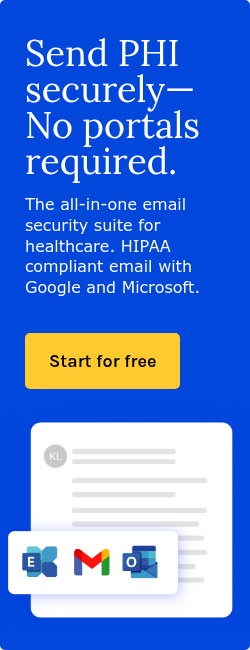
Email marketing remains a powerful tool for providers to connect with patients, share important health information, build stronger relationships, and improve health outcomes. However, unlike other industries, healthcare operates under the stringent regulations of HIPAA, requiring a balance between leveraging data-driven insights and safeguarding patient privacy.
As the Data and Marketing Association (DMA) emphasizes, "Email marketing continues to be hugely successful in building and maintaining profitable customer relationships," and this holds true for healthcare as well. However, the "rich measurement" possible with email must be carefully considered in light of HIPAA.
Key metrics
Just as vital signs provide insights into a patient's physical health, email marketing metrics offer a window into the effectiveness of your communication strategies. These metrics, as described in research on email marketing effectiveness, provide a "pulse" on your campaigns, revealing what resonates with your audience and what needs adjustment.
Open rate
This fundamental metric represents the percentage of recipients who open your emails. A low open rate could indicate issues with subject lines, sending time, or deliverability. A/B testing subject lines with variations in wording, length, and personalization can significantly impact open rates. Research on how to improve the performance of email marketing campaigns suggests that incorporating relevant emojis can further boost open rates. The same study found that adding "CEO" to the sender line can increase open rates, but this tactic should be used cautiously, considering the target audience and potential impact on unsubscribes.
Click-through rate (CTR)
CTR measures the percentage of recipients who click on a link within your email. This metric reveals how engaging your content is and how effectively it drives traffic to your website or desired resources. A low CTR might indicate a need to improve the relevance of your content, the clarity of your calls to action, or the design and placement of your links. Conducting A/B tests on different call-to-action buttons, link placement, and email copy can help optimize CTR.
Conversion rate
This metric tracks the percentage of recipients who complete a desired action after clicking a link in your email. This action could be anything from scheduling an appointment online to downloading a health resource or signing up for a newsletter. Conversion rates directly measure the effectiveness of an email campaign. Analyzing the conversion funnel—the steps a user takes from opening the email to completing the desired action—can identify areas for improvement.
Unsubscribe rate
While some unsubscribes are inevitable, a high unsubscribe rate can signal problems with your content, sending frequency, or targeting. Segmenting your audience and tailoring your messaging to specific groups can help reduce unsubscribes. Companies should also make it easy for users to unsubscribe to avoid spam complaints.
Bounce rate
This metric measures the percentage of emails that were not delivered. A high bounce rate can negatively impact your sender reputation and deliverability. Regularly cleaning your email list to remove invalid or inactive email addresses is required to maintain a low bounce rate. Differentiating between soft bounces (temporary delivery failures) and hard bounces (permanent delivery failures) can help diagnose deliverability issues.
Spam complaints
This metric tracks the number of recipients who mark your email as spam. A high number of spam complaints can severely damage your sender reputation and lead to your emails being blocked by ISPs (internet service providers). Avoiding spam trigger words like "free," "guaranteed," "limited time offer," or even seemingly harmless medical terms like "medicine" or "treatment" when combined with promotional language, can increase the likelihood of being marked as spam. Ensuring you have proper consent for sending emails and providing a clear unsubscribe option are all part of minimizing spam complaints. A paper on the advantages and disadvantages of email marketing notes the importance of avoiding practices that could lead to emails being perceived as spam.
Delivery rate
This metric represents the percentage of emails successfully delivered to recipients' inboxes. A high delivery rate is important for reaching your target audience and maximizing the impact of your campaigns. Using a reputable email marketing service with strong deliverability practices can help ensure your emails reach their intended recipients. The paper on the advantages and disadvantages of email marketing also emphasizes the importance of proper targeting and list management for successful email marketing.
Learn more: A healthcare email marketing ROI calculator
Why data matters in healthcare email marketing
Data is fundamental to effective marketing. It offers insights into patient behavior, preferences, and engagement, allowing you to refine strategies and maximize impact. In healthcare, data-driven decisions are not only about improving marketing outcomes; they're also about understanding patient needs, personalizing care, and improving health outcomes.
Email marketing metrics offer insights into how patients interact with your communications, informing your overall marketing strategy and enhancing patient engagement. However, the sensitive nature of healthcare data requires a cautious and compliant approach.
HIPAA compliance and email metrics
When tracking email metrics, healthcare providers must ensure they are not inadvertently collecting or storing protected health information (PHI). This includes avoiding the use of PHI in email subject lines, body copy, or tracking parameters. Providers must use a HIPAA compliant email marketing platform like Paubox Marketing to ensure the privacy and security of patient data. As noted in a research article on HIPAA and practice-based research, "safeguarding patient privacy is paramount when collecting and storing patient data, including information transmitted via email." This necessitates careful consideration of the data collected through email marketing and adherence to strict data privacy protocols.
Analyzing and interpreting metrics
Collecting data is only the first step. The real power lies in analyzing and interpreting the metrics to gain actionable insights and improve your email marketing performance. The DMA's white paper on email metrics and measurement provides excellent guidance on interpreting and using email marketing data effectively. For example, a low open rate might indicate a need to revise your subject lines or sending times, perhaps by A/B testing different variations. A low CTR could suggest that your content isn't resonating with your audience or that your calls to action aren't compelling or clearly visible, prompting a review of your email copy and button design. A high unsubscribe rate might signal a need to re-evaluate your sending frequency, content relevance, or target audience segmentation. High bounce rates point to necessary email list cleaning and validation. Finally, a spike in spam complaints necessitates a thorough review of your email practices to ensure compliance with spam regulations and recipient expectations. By analyzing these metrics, you can identify areas for improvement and optimize your email campaigns for better engagement and results.
Using data to improve patient engagement
Email marketing data can be used to personalize patient communication and build stronger relationships. By segmenting your audience based on demographics, health conditions, or engagement history, you can tailor your messaging to specific patient groups. For example, you could send targeted educational materials to patients with specific health conditions or personalized appointment reminders based on individual preferences. This personalized approach can lead to increased patient engagement, improved satisfaction, and better health outcomes.
Choosing the right email marketing platform
Selecting the right email marketing platform is necessary for healthcare providers. The platform should not only provide analytics and reporting features but also be fully HIPAA compliant to ensure the privacy and security of patient data. Paubox Marketing is a secure and compliant email marketing solution designed specifically for healthcare organizations. It allows providers to send, track, and analyze email campaigns while maintaining the highest standards of patient privacy. With Paubox Marketing, you can leverage the power of email marketing to engage patients effectively without compromising HIPAA compliance.
FAQs
Does HIPAA apply to internal email communications within my healthcare organization?
Yes, HIPAA applies to all forms of PHI, including internal emails. Ensure your internal communication practices also adhere to HIPAA guidelines, especially when discussing patient-specific information.
Beyond open rates and clicks, how can I measure the real-world impact of my email campaigns?
Connect your email marketing to tangible outcomes. Track appointment bookings, website traffic originating from email links, or patient inquiries generated by your campaigns. For broader impact, consider patient surveys to gauge satisfaction and information retention related to email content.
Besides using a HIPAA compliant email marketing platform, what other security measures should I consider?
Implement strong password policies, train your staff on HIPAA compliance best practices, and regularly review and update your security protocols. Consider using two-factor authentication for accessing email accounts and marketing platforms.
Subscribe to Paubox Weekly
Every Friday we'll bring you the most important news from Paubox. Our aim is to make you smarter, faster.




